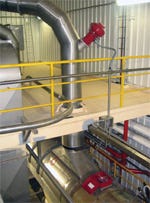The Importance of Risk Management Programs in Explosion Protection and Prevention
April 23, 2008
The recent dust explosion at a sugar refinery in Georgia serves as a dangerous reminder of the risks faced by processing plants that handle combustible powders. When that tragic explosion was reported, most people were left wondering how sugar, a common pantry item, could explode. Industry experts are aware of the explosive nature of everyday items such as sugars, grains, flours, starch, pesticides, wood products, and plastics. They understand that based on their explosive index (Kst value), these materials can ignite and generate a destructive force under the right conditions.
Explosions result from the ignition of a combustible material (dust, gas, or vapor) when it is mixed with oxygen in the air. When an explosion takes place inside a process or storage enclosure, the rapid rise in pressure exerts a destructive force within a few milliseconds that places both personnel and equipment at risk. Most material-handling, processing, and storage equipment is not designed to resist the pressure of such a deflagration. Only equipment designed to resist the maximum pressure (Pmax) that results from the combustion process can survive. Such design pressures typically exceed 75 psig (5.2 bar), making design for containment of a deflagration a costly proposition.
Understanding the Risks
The successful management of deflagration risks requires that personnel understand the characteristics (e.g., Pmax and Kst) of the materials with which they work and the process conditions in the facility (e.g., dust concentration, airflow velocity, operating pressure, temperature, and humidity).
The National Fire Protection Association (NFPA) divides potentially explosive materials into classes. Class ST1 has a Kst value of more than zero but less than or equal to 200 bar m/sec. ST2 covers Kst values 200 through 300. ST3 covers a range greater than 300 bar m/sec. The higher the Kst value, the higher the explosiveness of the material. For example, sugar has a recorded Kst value of 138.
A fine-sugar-dust explosion can generate a pressure in excess of 100 psi within enclosed process equipment in less than 100 ms.
|
Explosion suppression of a dust collector. Isolation |
To combat deflagration risks, industry is provided with recently updated tools in the form of standards published by NFPA. The NFPA standards covering explosion prevention and protection (68-2007, 69-2008, and 654-2006) require that a documented risk program be in place for all combustible-dust hazards. The Occupational Health and Safety Administration (OSHA) National Emphasis Program on combustible-dust processes released on October 18, 2007, underwrites the full requirements of these NFPA standards.
Representing best engineering practice, these standards are designed to protect facilities from combustible-dust explosions. They identify the measures that should be taken to avoid dust explosions, indicating that facilities and work practices should be designed to prevent the production and spread of dust while controlling ignition sources. They also provide mitigation recommendations for explosions that cannot be prevented. Simple and inexpensive housekeeping measures are often the first step in risk management.
The NFPA standards are typically adopted by state fire marshals, insurance companies, and consultants as the basis for determining best engineering practices. They apply to “all phases of the manufacturing, processing, blending, pneumatic conveying, repackaging, and handling of combustible particulate solids or hybrid mixtures, regardless of concentration or particle sizes, where the materials present a fire or explosion hazard.”
Preliminary Steps: Asking the Right Questions
According to a recent combustible-dust hazard study conducted by the U.S. Chemical Safety and Hazard Investigation Board, nearly 280 dust fires and explosions have occurred in U.S. industrial facilities over the past 25 years, resulting in 119 fatalities and more than 700 injuries. Preventing these hazards from recurring begins in the planning stages by identifying risks and determining the explosive reactivity properties of the combustible process materials. After an initial analysis, the next step is to understand what explosion protection and prevention options are available.
In terms of equipment costs and simple periodic inspection requirements, the most economical means of protecting against explosions is the use of explosion vent technology. However, many factors must be considered before choosing explosion vents:
• Is the flame ball that is ejected from an open vent acceptable? It will usually exceed 30 ft in length and about half that in diameter. An 1800-cu-ft vessel venting from a single position will produce a flame ball more than 100 ft in length and 50 ft in diameter. The flame must be vented to a safe location to avoid injuring personnel or damaging equipment.
• If venting equipment is installed indoors, can a vent duct to a safe outdoor location be provided? Vent ducts always increase the required vent area and may not be acceptable for protecting smaller process volumes at higher Kst values.
• Can the required vent area be accommodated? In addition to the space required for a vent, can the reaction forces during venting be sustained? For tall equipment, can a near-thrust-neutral vent arrangement (a roof-mounted vent) be used to prevent collapse during relief?
• If the protected equipment has process inlets and outlets, are they protected to prevent the spread of the deflagration to other equipment or work areas? Codes and standards clearly require the isolation of vented equipment to prevent secondary explosions. The potential for damage and destruction is typically much greater with secondary explosions.
• Is cleanup after a vented explosion acceptable? Depending on the design, a vented explosion may require a company to replace capital equipment components that have been damaged by the pressure wave, resulting in production losses.
• What will the neighbors think? A vented explosion is a spectacular event that will draw considerable community attention.
• What if the process material in question is toxic or hazardous? Certain materials cannot be released through vents.
|
Explosion venting of a dust collector |
Each process must be considered individually and as part of the production facility to ensure implementation of the right explosion protection and prevention technology. There are always options. The technical solution a company adopts must take the practical needs of each process into consideration.
Meeting NFPA Standards through User-Friendly Designs
The owner/operator of a combustible-dust processing or handling facility can choose from a range of safety measures to meet NFPA Standards 68-2007, 69-2008, and 654-2006. Typically, one or more of the following measures should be taken:
• Housekeeping by design or based on controlled operating procedures should be implemented to eliminate or minimize combustible-dust accumulation.
• Equipment grounding and appropriately rated electrical systems should be installed to eliminate or minimize static-electricity buildup. Companies must periodically inspect these systems to ensure that they remain effective. Electrical systems should be designed for the hazardous areas in which they will be used.
• Equipment should be vented to safely discharge combustion products from a dust explosion to atmosphere. The goal is to contain the pressure generated inside protected equipment below safe design limits. Companies should ensure that the flame ball generated by venting is acceptable. If it is not acceptable and the equipment is indoors, flameless venting or ducting to atmosphere should be considered.
• Equipment isolation barriers should be used to prevent flame propagation and prevent a primary dust explosion from becoming a secondary (and typically much more severe) event. Solutions may include implementing appropriately rated rotary airlocks, appropriately designed screw conveyors, mechanical isolation barriers (pinch valves and knife-gate valves), and chemical isolation barriers (which are particularly well suited to large and irregularly shaped ducting).
• Equipment suppression should be implemented to detect a dust explosion in the making and extinguish it using appropriate quenching agents.
• Optical spark detection equipment should be installed to detect the presence of hot particles in a pneumatic airflow or conveyor belt and prevent them from reaching process equipment and becoming an ignition source.
• Relief diverters using piping should be used to divert a flame upward through a rupture disk to an outside space away from the plant.
|
Explosion venting of a dust collector |
Reducing the Risks: A Concrete Example
Practicing plant safety reduces the potential risk of fire and explosions by identifying potential hazards within the plant and designing systems, processes, and procedures to reduce the amount of ignitable hazards. To understand how explosion protection and suppression works, it is useful to consider the explosion triggers that exist in a typical low-capacity powder-processing plant (illustrated schematically in Figure 1).
|
Chemical isolation of a duct rising from a fluidized bed below |
Product such as grain or powder chemicals enters zone A from the left via a pneumatic system, after which it is dispersed into the first tank (the dryer). As the material dries, the heavier material falls to the bottom of the tank for further processing. Then it is sent to zone C. Meanwhile, dust and lighter material are carried into zone B, where they are collected by filters. The heavier material falls to the bottom and is then carried to zone C for final processing.
Each zone is interconnected. If an explosion occurs in one zone, it can spread to other zones. An explosion vent or explosion suppression system combined with a chemical isolation system or fast-acting valve may be the best solution. However, an explosion vent that does not have an isolation unit to prevent flames from moving from one zone to the next does not meet NFPA standards. In this illustration, the explosion-suppression system, noted in red in Figure 1, extinguishes the fireball as it occurs, rapidly injecting heat-quenching agent into the tanks and duct to extinguish the fireball. The outside world does not hear or see the fireball. The readings from the sensor and monitor are the only indication that an explosion has occurred.
Historically, powder-processing plants have been protected by explosion vents on the dryer and collector. When combustible gas, mist, or dust meets an ignitable source, an explosion occurs, which is deflected through the explosion vent. At a predetermined burst pressure, an unrestricted opening forms in the vent, allowing combustion gases to expand and flow through it. The vent is suitable for equipment that is not connected to other equipment by ducts. But if the tanks are connected, flame can enter the ducts, leading to tank explosions in zones A, B, and C. Compliance with NFPA 654 guidelines requires plants to protect tanks that are connected.
|
Chemical isolation of large-diameter ducting |
To achieve that level of protection, the bottom of each tank has a rotary airlock that is designed to prevent flame propagation. At the same time, the pneumatic ducting between each zone is fitted with chemical isolation barriers. Venting must also be positioned so that it can relieve safely, preferably outside—away from people, buildings, and roads. Vent ducting is often needed to divert the explosion flame ball and pressure pulse outside the building.
Conclusion
New tools exist to help the owner/operator of a combustible-dust-processing facility to develop a risk evaluation and risk management program. The OSHA National Emphasis Program comes at a time when industry can respond to the safety challenge. Expert advice is available from personnel who have contributed their time and knowledge to create world-class NFPA standards. Information is also available from the manufacturers of safety technology whose equipment has been performance tested by Nationally Recognized Testing Laboratories.
Thankfully, plant explosions are not routine occurrences. However, it is the unusual events in the life of a plant that typically trigger explosions. Processors should plan for the abnormal and maintain a strict policy of foreseeing the potential effects of product material changes, hardware changes, and procedural changes. In even the best-protected facilities, dust explosion risk management requires constant vigilance.
Geof Brazier is president of Industrial Protection Devices LLC (Minneapolis, MN). Mitch Rooker is senior development engineer at BS&B Safety Systems LLC (Tulsa, OK). Both serve as members of the NFPA Committee on Explosion Protection Systems. For more information on Industrial Protection Devices LLC, call 952-941-0146. For more information on BS&B Safety Systems, call 800-272-3475 or visit www.bsbsystems.com.
About the Author(s)
You May Also Like









